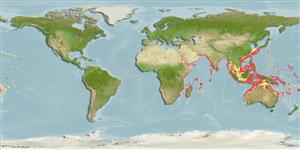>
Eupercaria/misc (Various families in series Eupercaria) >
Lutjanidae (Snappers) > Etelinae
Etymology: Pristipomoides: Greek, pristis = saw + Greek, poma, -atos = cover, operculum + Greek, oides = similar to (Ref. 45335).
More on author: Day.
Environment: milieu / climate zone / depth range / distribution range
Ecologia
marinhas demersal; intervalo de profundidade 40 - 350 m (Ref. 9821), usually 125 - 275 m (Ref. 82366). Tropical; 32°N - 36°S, 33°E - 157°W
Indo-Pacific: East Africa and Red Sea to Samoa, and southern Japan southward to Australia.
Comprimento de primeira maturação / Tamanho / Peso / Idade
Maturity: Lm 41.7, range 35 - 50 cm
Max length : 90.0 cm TL macho/indeterminado; (Ref. 5484); common length : 70.0 cm TL macho/indeterminado; (Ref. 5450); idade máx. registrada: 30 anos (Ref. 46116)
Espinhos dorsais (total): 10; Raios dorsais (total): 11; Espinhos anais 3; Raios anais : 8. Interorbital space flat. Lower jaw slightly protruding. Bases of dorsal and anal fin without scales, their last soft rays extended into shorts filaments. Pectoral fins long, reaching level of anus. Scale rows on back parallel to lateral line. Side of snout and cheek with 2 golden stripes bordered with blue. Top of head with a series of chevron-shaped yellow bands.
Gold band snappers are deepwater fish inhabiting tropical and sub-tropical waters. They are schooling fish and live in areas of hard, rocky and uneven sea floor and steep off islands (Ref. 27354). They feed on fishes, shrimps, crabs, lobsters, stomatopods, squids, gastropods and urochordates. Marketed fresh. An excellent food fish. Maximum depth from Ref. 082366.
Studies in the South China Sea (Ref. 28116) and Hawaii (Ref. 28117) suggest that this species is a serial spawner (Ref. 28115). Similar studies in Australia suggest that this species is a multiple spawner, perhaps a serial spawner (Ref. 6390).
Allen, G.R., 1985. FAO Species Catalogue. Vol. 6. Snappers of the world. An annotated and illustrated catalogue of lutjanid species known to date. FAO Fish. Synop. 125(6):208 p. Rome: FAO. (Ref. 55)
Status na Lista Vermelha da UICN (Ref. 130435)
Ameaça para os humanos
Harmless
Uso pelos humanos
Pescarias: espécies comerciais
Mais informação
ReferênciasAquaculturaPerfil para aquaculturaEstirpesGenéticaElectrophoresesHereditariedadeDoençasProcessamentoNutrientsConversão de massa
Ferramentas
Relatórios especiais
Baixar XML
Fontes da internet
Estimates based on models
Preferred temperature (Ref.
123201): 12.3 - 23, mean 17 °C (based on 372 cells).
Índice de diversidade filogenética (Ref.
82804): PD
50 = 0.5005 [Uniqueness, from 0.5 = low to 2.0 = high].
Bayesian length-weight: a=0.01660 (0.01006 - 0.02739), b=2.95 (2.82 - 3.08), in cm total length, based on LWR estimates for this species & Genus-body shape (Ref.
93245).
Nível Trófico (Ref.
69278): 3.8 ±0.58 se; based on food items.
Resiliência (Ref.
120179): médio(a), tempo mínimo de duplicação da população 1,4 - 4,4 anos (K=0.22-0.28; tmax=14; Fec=296,000).
Prior r = 0.67, 95% CL = 0.44 - 1.01, Based on 1 stock assessment.
Fishing Vulnerability (Ref.
59153): Moderate vulnerability (43 of 100).
Climate Vulnerability (Ref.
125649): High to very high vulnerability (75 of 100).
Nutrients (Ref.
124155): Calcium = 71.6 [28.0, 146.4] mg/100g; Iron = 0.886 [0.467, 1.509] mg/100g; Protein = 18.3 [16.5, 19.9] %; Omega3 = 0.247 [0.147, 0.429] g/100g; Selenium = 90.7 [50.6, 173.7] μg/100g; VitaminA = 14.3 [4.8, 44.4] μg/100g; Zinc = 0.823 [0.551, 1.196] mg/100g (wet weight);
